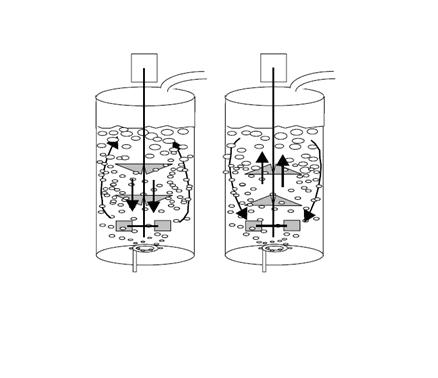For agitating vessels with a high aspect ratio, a multi-layer agitator is required when a single layer of paddle is not used to achieve good mixing capability, such as in the fermentation industry.
In the multi-layer agitator, various types of agitator combinations are often used to obtain a higher agitation effect, so that the axial circulation ability and the shear dispersing ability are comprehensively balanced. For example, some mixing processes require both circulation and shearing. At this time, a wide-leaf-wing type agitator with a high circulation capacity of the upper two layers is used, and a half-tube disk impeller with a strong shearing force is used in the lower layer.
The layer spacing between the different layers of the paddles has a large effect on the dispersion of the gas. Increasing the layer spacing increases the dispersion performance of the lower impeller and increases the average gas holdup.
7 New mixers Now, there are some new developments in gas-liquid reaction and agitation systems: (1) High vapor pressure systems, such as boiling. (2) High gas velocity behavior (apparent gas velocity  0.08 m/s). (3) The expansion of the range of the agitator, including the design of the concave paddle and the hydroforming of the wide blade. (4) Correct calculation of the gas recycling rate and its mass transfer driving force relationship.
In gas-liquid agitation, research institutes and companies have begun to design new types of agitators in order to obtain longer gas residence times or better gas flow patterns.
For example, some reactors add a self-priming agitator to the surface of the liquid to return the spilled gas back to the liquid, increasing the residence time of the gas.
Some experts are working on a stirrer that can change the gas flow pattern, as shown below. This is a multi-layered paddle, the lowermost layer is the radial flow paddle, and the upper two layers are the wing flow paddles that act as a suction. The wing flow paddle can forcefully improve the gas flow pattern.
8 Application of gas-liquid mixing equipment Gas-liquid mixing equipment is mainly used for physical and chemical processes such as hydrogenation and oxidizing gas removal. In the processes of hydrogenation, oxidation, chlorination, sulfonation, etc., a stirrer is required to provide a high gas-liquid dispersion capacity and increase the residence time of the gas. In the process of fermentation, etc., it is necessary to take both cyclic and shearing, and it is preferable to use a multilayer composite paddle.
 |